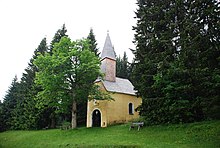Hebalm Chapel
The Roman Catholic Hebalm Chapel is located in the Hebalm in the south of the Pack district in the Hirschegg-Pack municipality in the Voitsberg district in Styria . The chapel of the parish church Pack , consecrated for the feast of the Visitation of the Virgin Mary , belongs to the deanery Voitsberg in the diocese of Graz-Seckau . Its interior is seldom accessible, only on the days of the Hebalmkirtage held until 2015, a service was read in the chapel.
history
The first chapel on the Hebalm was built in 1685 by the Saurau rulers at the time. It was dedicated to the Visitation of Mary. It is believed that the church was built because of the plague epidemic prevailing at the time on the border that formed the Hebalmhöhe. A mass celebration is documented for the first time in 1691, this service was held by the pastor of Schwanberg. From 1696 the pastor of the Parish Pack was active for these services, through whom the masses are organized and held until the 21st century. In 1784 the parish of Pack called the place “Capela BVMaria visito in Alpibus”.
From 1770 regular annual and cattle markets should have taken place at the chapel. In this year, a restaurant "under the Seeberg" (elevation north of the lake Eben ) is documented for the first time, as is the landlord named Mathias Lind. In the following years, with the approval of the episcopal ordinariate of Seckau, a priest named Franz Unterholzer, who was taken in and paid for by the landlord, lived near the chapel; his accommodation was the restaurant. Protests by the surrounding pastors were unsuccessful. Carters and traders who crossed the border at that time took part in his services, as did visitors to the Kirtage.
In 1796 Franz Unterholzer was represented because of illness by another priest named Scherz, who also helped out in the surrounding parishes. After the death of Franz Unterholzer in 1802, a Capuchin priest from Schwanberg, Christophorus Schlierger, was brought in, but he returned to his monastery in 1806. After that there was no longer any priest living on the Hebalm.
The Kirtage and cattle markets, which were held on the Sundays closest to the feasts of the Visitation of the Virgin (July 2nd) and St. Bartholomew (August 24th), continued, the church services at the chapel were held by the parish on these days Pack kept out. The tradition of holding the second Hebalmkirtag on the Sunday after this festival resulted from the proximity to the Feast of the Assumption of Mary (known in the area as the Great Women's Day ). In 1823 it is reported that around 400 people took part in the service, the other around 1600 Kirtag visitors stayed at the restaurant and at the fair, where they also drank and celebrated during the service. The priests refused, but the services continued on the grounds that otherwise the people would stay away from the church at all. The combination of Kirtag dates (and the dissolute circumstances criticized at the time) with church services was often criticized, but a separation failed, among other things, because the Kirtag area (today: around the Hebalm shelter) and the chapel were in different administrative districts. The chapel is still in the Voitsberg district today, while the Kirtags area is in Deutschlandsberg.
In 1833 the chapel (then known as "auf der Stockeralpen") was dilapidated and was renovated and re-consecrated the following year. At that time, the owner was still the Saurau lordship, whose alpine pastures and inn were leased. In 1834 the construction of another inn is reported about half an hour away. It is believed that it was the cloth hut.
In 1872 an extraordinary penitential and supplication procession was held on the occasion of the church services that have existed for 100 years on the Stockeralm. In addition to the Kirtag dates, masses were also held at the chapel when the then owner of the Hebalmgüter, Count Leopold Goeß von Ligist, or his employees were there.
In 1796 a dispute about this chapel between the parishes of Osterwitz and Pack is reported: the holding of masses (reading of masses ) by an Osterwitz chaplain was rejected by the dean from Edelschrott , as was the pastor of Preitenegg . The reason was that servants and maids “had the opportunity to have evil meetings and socialize. “The fact that the chaplain from Osterwitz read masses in the chapel, like the earlier Marian patronage, is evidence that the chapel was looked after by the Osterwitz parish before the borders were reorganized in the 19th century.
Furnishing
The altarpiece, painted in 1974, shows the conversion legend of St. Hubertus in a modern painting style (encounter with a deer carrying a cross between the antlers). The patronage is reflected in the altar equipment by a picture of Mary above the altar leaf (main picture of the altar).
In the chapel tower there is a small, brightly sounding bell that can be rung by a pull rope when the chapel is open. The roof of the chapel was re-covered with wooden shingles around the year 2000. The chapel gate is decorated with the Maltese cross .
Web links
Individual evidence
- ↑ Messkapelle: Visitation of the Virgin Mary on the Hebalpe
- ↑ a b c d e f Herbert Kriegl: The Hebalm in its earlier meaning. About “illegal” church services, immoral events and “Bacchus festivals”. In: Weststeirische Rundschau. No. 38, volume 2016 (23 September 2016), 89th volume. ZDB -ID 2303595-X . Simadruck Aigner u. Weisi, Deutschlandsberg 2016, p. 5.
- ^ Gerhard Fischer: Osterwitz. a miraculous place in the high pürg. Life, joy and suffering of an area and its inhabitants. Osterwitz 2002. Editor and publisher: Osterwitz community. Production: Simadruck Aigner & Weisi, Deutschlandsberg. No ISBN. P. 178.
Coordinates: 46 ° 54 '46.9 " N , 15 ° 1' 48.4" E
